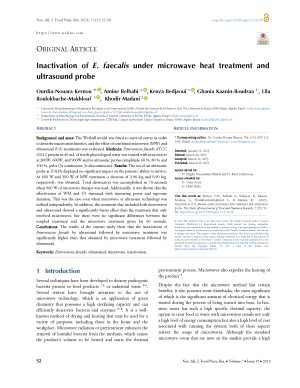Inactivation of E. faecalis under microwave heat treatment and ultrasound probe
Abstract
Background and aims: The Weibull model was fitted to survival curves in order to describe inactivation kinetics, and the effect of combined microwave (MW) and ultrasound (US) treatments was evaluated. Methods: Enterococcus faecalis ATCC 29212 present in 40 mL of sterile physiological water was treated with microwaves at 300W, 600W, and 900W and/or ultrasonic probes (amplitude 60 %, 80 % and 100 %, pulse (3s continuous, 3s discontinuous). Results: The use of an ultrasonic probe at 20 kHz displayed no significant impact on the patients' ability to survive. At 600 W and 300 W of MW treatment, a decrease of 3.96 log and 0.90 log, respectively, was obtained. Total destruction was accomplished in 70 seconds when 900 W of microwave therapy was used. Additionally, it was shown that the effectiveness of WM and US increased with increasing power and exposure duration. This was the case even when microwave or ultrasonic technology was utilized independently. In addition, the treatment that included both microwaves and ultrasound showed a significantly better effect than the treatment that only involved microwaves, but there were no significant differences between the coupled treatment and the microwave treatment given for 30 seconds. Conclusions: The results of the current study show that the inactivation of Enterococcus faecalis by ultrasound followed by microwave treatment was significantly higher than that obtained by microwave treatment followed by ultrasound.
Full text article
Authors
Copyright (c) 2023 Nouara Kernou, Amine Belbahi, Kenza Bedjaoui, Ghania Kaanin-Boudraa , Lila Boulekbache, Khodir Madani

This work is licensed under a Creative Commons Attribution 4.0 International License.
-
Attribution — You must give appropriate credit, provide a link to the license, and indicate if changes were made. You may do so in any reasonable manner, but not in any way that suggests the licensor endorses you or your use.
-
No additional restrictions — You may not apply legal terms or technological measures that legally restrict others from doing anything the license permits.





